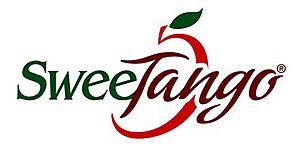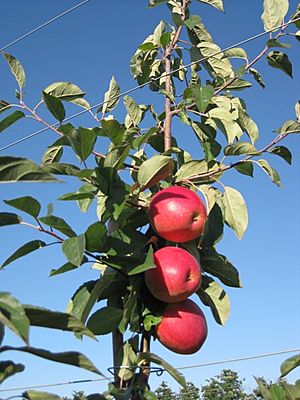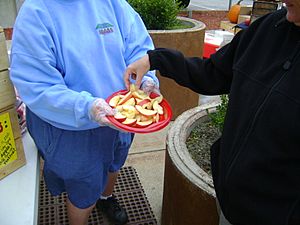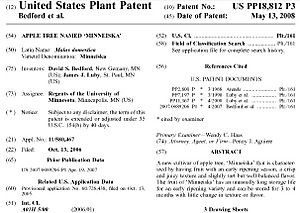SweeTango facts for kids
Quick facts for kids  |
|
| Hybrid parentage | Honeycrisp and Zestar Apple |
|---|---|
| Cultivar | Minneiska |
| Origin | University of Minnesota, United States |
The SweeTango is a special kind of apple, known by its brand name. Its official name is 'Minneiska'. This apple is a mix of two other popular apples: the 'Honeycrisp' and the 'Zestar!' apple. The University of Minnesota owns the trademark for the SweeTango name. This means they control who can grow and sell these apples. The SweeTango apple has a sweet and slightly tart taste. Some people describe its flavor as a mix of brown sugar and spiced apple cider.
The University of Minnesota gave a company called Pepin Heights Orchards the special right to grow and sell the 'Minneiska' apple. This company then created a group of selected farmers who could also grow the apple. At first, only farmers in Minnesota could join this group. Later, more farmers in the northern parts of the United States were allowed to grow them. This idea of controlling who could grow a certain type of fruit was new in the United States.
Contents
How the SweeTango Apple Was Made
The SweeTango apple is a specific type of apple called a cultivar. It was created by the University of Minnesota in 1999. It became available to the public in 2007. This apple is a mix of two other apple types that the university also developed: the 'Honeycrisp' and the 'Minnewashta' (which is also known as Zestar!). Think of it like this: the 'Honeycrisp' and 'Minnewashta' are the parent apples, and the 'Minneiska' is their fruit "offspring."
The name "SweeTango" is a registered trademark owned by the University of Minnesota. When it was being developed, this new apple was known as MN 1914. It was created at the university's Horticultural Research Center, which has a large farm near Victoria, Minnesota.
Growing SweeTango Apples
SweeTango apples are ready to pick early in the season. They usually start ripening in late August and are ready by the first week of September in places like Excelsior, Minnesota. This is a little after the Zestar! apple and a few weeks before the Honeycrisp.
These apples are sold in stores in the eastern United States and Canada starting in September. They often cost more than other apples because they are special. You can sometimes pick them directly from the tree in certain areas. They can also be bought online from mid-September to mid-November, depending on where you live.
The 'Minneiska' apple was specially grown to have 20 different good qualities. Some of the most important features include:
- It ripens earlier than most other apples.
- It has a very crisp texture, which makes it extra juicy.
- It stays fresh and tasty for a long time in storage.
People often compare the SweeTango apple to the 'Honeycrisp' apple, which is the state fruit of Minnesota.
The 'Minneiska' apple has a texture similar to its parent apples, 'Minnewashta' and 'Honeycrisp'. It has a slightly tart, spicy, and citrusy flavor. The name "SweeTango" comes from combining "sweet" and "tang" (meaning a strong, sharp taste). It's a pinkish apple with a yellow background and red spots. Its strong flavors are more complex than the Honeycrisp. Some people say it tastes like spiced apple cider or has a zesty, sweet-tart flavor with hints of brown sugar.
SweeTango apples have larger cells inside them than most other apples. When you bite into one, these cells break in a special way. This makes a unique cracking sound that's different from other apples. One writer even described it as sounding like a karate chop breaking a board!
How SweeTango Apples Are Controlled
The University of Minnesota gave special rights to Pepin Heights Orchards, the biggest apple orchard in Minnesota. These rights allowed them to grow, have others grow, and sell the 'Minneiska' apple. In 2006, Pepin Heights Orchards created a group of 45 apple growers called Next Big Thing. At first, only commercial growers in Minnesota could be part of this group. They were only allowed to plant a small number of 'Minneiska' trees compared to other apple trees.
Later, the group expanded to include members from states like Michigan, Washington, and New York. Only members of this group could grow the SweeTango apple. Members pay a fee to get a license to grow the 'Minneiska' trees. They can only sell their apples through the cooperative group. This way of controlling a fruit variety, called a "managed variety," was new in the United States when the apple was developed. It helps keep the quality of the apples very high.
This special control system caused some discussion because the apple was developed by a public university. In 2010, there was a challenge to the university's right to sell exclusive growing rights. In 2012, a court decided that the agreement was legal. However, other parts of the challenge were settled. This allowed smaller growers to plant a limited number of 'Minneiska' trees (up to three thousand per orchard). These apples could only be sold directly to customers, not to big wholesale markets.
SweeTango Apple's Unique Traits
The University of Minnesota owns the trademark for the SweeTango apple. The scientists who developed this apple, David S. Bedford and James J. Luby, received a patent for it in 2008. A patent is like a special protection that means no one else can grow or sell this specific plant without permission from the patent owner.
The 'Minneiska' apple's scientific name is Malus domestica. The patent explains that it is a unique new type of apple created using special growing methods like grafting. Plant patents usually last for 20 years. They stop others from growing or selling the plant without permission.
In 2009, a small number of SweeTango apples were sold in stores. By 2013, you could find them in stores across the United States and eastern Canada. The university's apple breeding program continues to create new types of apples. For example, they developed a new apple called "Frostbite" in 2014. They are also working on other new varieties, like one called "First Kiss," which looks very promising.




